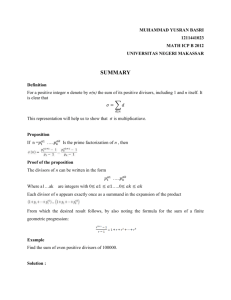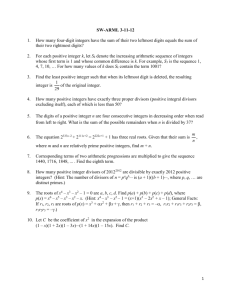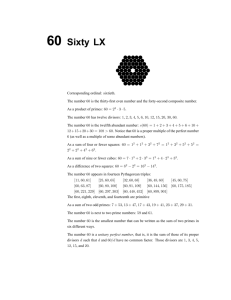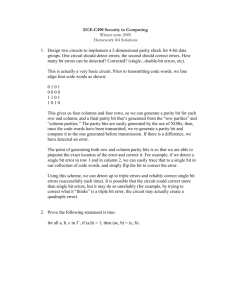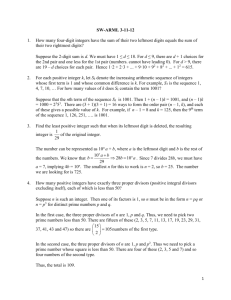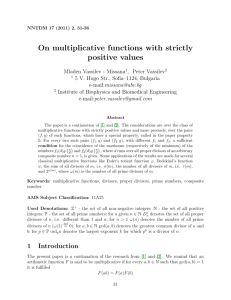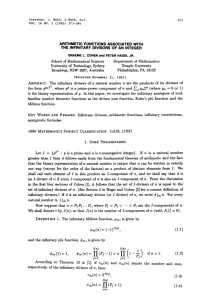divisibility_2_print.. - School of Computer Science
advertisement
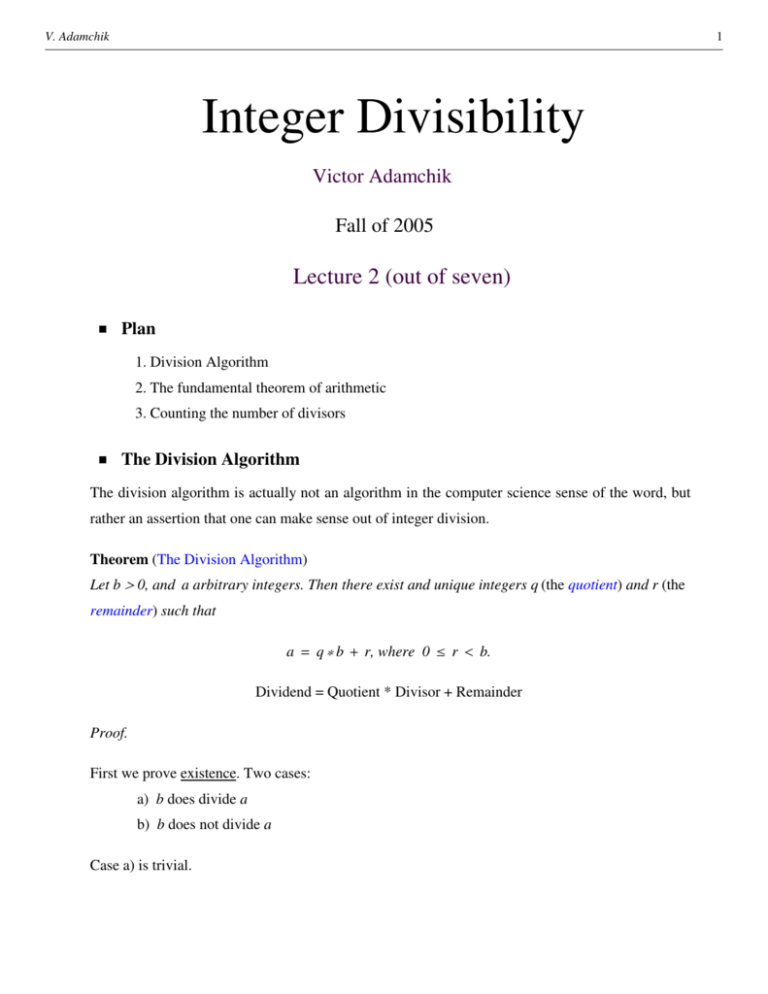
V. Adamchik 1 Integer Divisibility Victor Adamchik Fall of 2005 Lecture 2 (out of seven) Plan 1. Division Algorithm 2. The fundamental theorem of arithmetic 3. Counting the number of divisors The Division Algorithm The division algorithm is actually not an algorithm in the computer science sense of the word, but rather an assertion that one can make sense out of integer division. Theorem (The Division Algorithm) Let b 0, and a arbitrary integers. Then there exist and unique integers q (the quotient) and r (the remainder) such that a q b r, where 0 r b. Dividend = Quotient * Divisor + Remainder Proof. First we prove existence. Two cases: a) b does divide a b) b does not divide a Case a) is trivial. V. Adamchik 21-127: Concepts of Mathematics Case b). Given that b does not divide a. Consider the following set S Example, b 3 and a a q b q a q b 0 . 10 10 q 3 q 1, 4, 7, 10, 13, ... 3, 2, 1, 0, 1, ... S is not empty. We must prove this statement. Again, two cases to consider. If a 0, choose q 0, so a If a 0, choose q a 1 b S. a, then a a b a b 1 0 is in the set. Observe, that 0 since b cannot be equal 1. Why? Because of our assumption "b does not divide a." Axiom (Well-Ordering Principle) Every nonempty set of natural numbers contains a smallest element. Since S is the set of non-negative integers it must contain a least element, say, r 0 . r0 0 We prove that r 0 Case 1. Let r 0 min S r0 a q0 b a q0 b b b (by contradiction) b Substitute this into the above formula for r0 0 Collect terms in b a b q0 b This implies that b a q0 1 b V. Adamchik 3 which contradicts to Case b) assumption that b Case 2. Let r0 Consider r0 b 0. b. It's positive r0 Next we show that r0 b b 0 and also r0 b r0 . S r0 Therefore, r0 a. b a q0 b b a q0 1 b b is in S and it is smaller than r0 . Contradiction to the minimality of r 0 . It remains to prove that q and r are unique. Suppose that q0 b q1 b a a where 0 ri b and r0 r0 r1 r1 . Substract one equation frpm another, we obtain 0 q0 0 According to our assumption 0 b b b r1 q1 b q0 q0 r0 0 q1 r0 r1 r0 q1 r1 r1 r0 b. Therefore, b 0 q0 q1 q0 q1 q0 q1 b 1 QED The cancellation law. We have used an important property of the integers: x y S 0 implies x 0 or y 0. It says that there are no nonzero zero-divisors in the integers. Exercise. Where will the proof fail if you allow negative remainders? V. Adamchik 21-127: Concepts of Mathematics Exercise. Reformulate the above theorem when b 0 is not necessarily positive. Here is a simple application of the Division Algorithm. Lemma: Let p be prime. Then p a b implies that p a or p b. Proof: By the division algorithm, we can write a where 0 r1 , r2 q1 p r1 and b q2 p r2 . p. Hence, a b a b q1 q2 p2 q1 r2 p p q1 q2 p q2 r 1 p q1 r2 q2 r1 r1 r2 r1 r2 Given that p divides a b, therefore, p r1 r2 . It follows then that the remainder r1 r2 must be 0. But then r1 or r2 must be 0, so that p divides a or b. QED Exercise. Argue that p r1 r2 if r1 r2 Application.We prove that 0. Note p is prime. 2 is irrational. Proof. (by contradiction) Let 2 p q , in lowest terms - no common divisors. Then 2 Assume p 2 p2 q2 2 q2 p2 2 p2 2 p p 2 p c, c Then 2 q2 p2 2 q2 4 c2 q2 2 c2 2 q2 2 q Contradiction, p and q have a common divisor 2. QED. Exercise. Where will the proof fail if you try to prove that 4 is irrational? V. Adamchik 5 The Fundamental Theorem of Arithmetic One of the beautiful properties of the prime numbers is that every positive integer can be written as a product of primes. Theorem (The Fundamental Theorem of Arithmetic) Let n 2 be an integer. Then there exist primes p1 , p2 , …, pk such that n p1 p2 … pk . If we require in addition that the sequence p1 , p2 , …, pk is ordered, then it is uniquely determined by n. Example of prime factorization 300 = 2 * 2 * 3 * 5 * 5 Proof. First existence. We use in induction on n. The base case n 2 is obvious Inductive Hypothesis: numbers up to n 1 can be writen as a product of primes. Inductive step: If n is prime, there is nothing to show. Otherwise, n a b where 1 a, b n. By IH, both a and b can be written as products of primes, and our claim follows. Uniqueness of the factorization. Suppose n p1 p2 … pk q1 q2 … qs where both sequences of primes are ordered. Since p1 divides the second product, we must have p1 By a similar argument, q 1 p j for some j. q i for some i. But then p1 q i. V. Adamchik 21-127: Concepts of Mathematics It follows from the order assumption that p 1 p2 … q 1 , so that pk q2 … q s. By continuing in this way, we see that each pk must be paired with q j . Apart from the order of the factors. QED. Corollary. Every positive integer 1 can be written uniquely (except for order) in the form p1 e1 x p2 e2 pn em , ... pi p j for i j Counting divisors Observation. Count the number of positive divisors 21 2 has two divisors 1 and 2, 2 4 has three divisors 1,2 and 4, 4 12 has six divisors 1,2,3,4,6 and12, 12 22 3 300 has 18 divisors, 300 22 3 22 Each divisor of 300 3 22 52 must be in the form 2i where 0 3 2 3 i 2, 0 j 52 1, 0 k 3j 5k 2, otherwise it won't divide 300. These will give us 18 choices. We use here the rule of product. The rule of product: Friday night out: assuming that you can go to movies (5 choices) and then go to a party (3 choices), in how many ways can you spend the evening? Theorem. Integer x has e1 1 e2 1 ... em p1 e1 1 divisors. p2 e2 ... pn em
